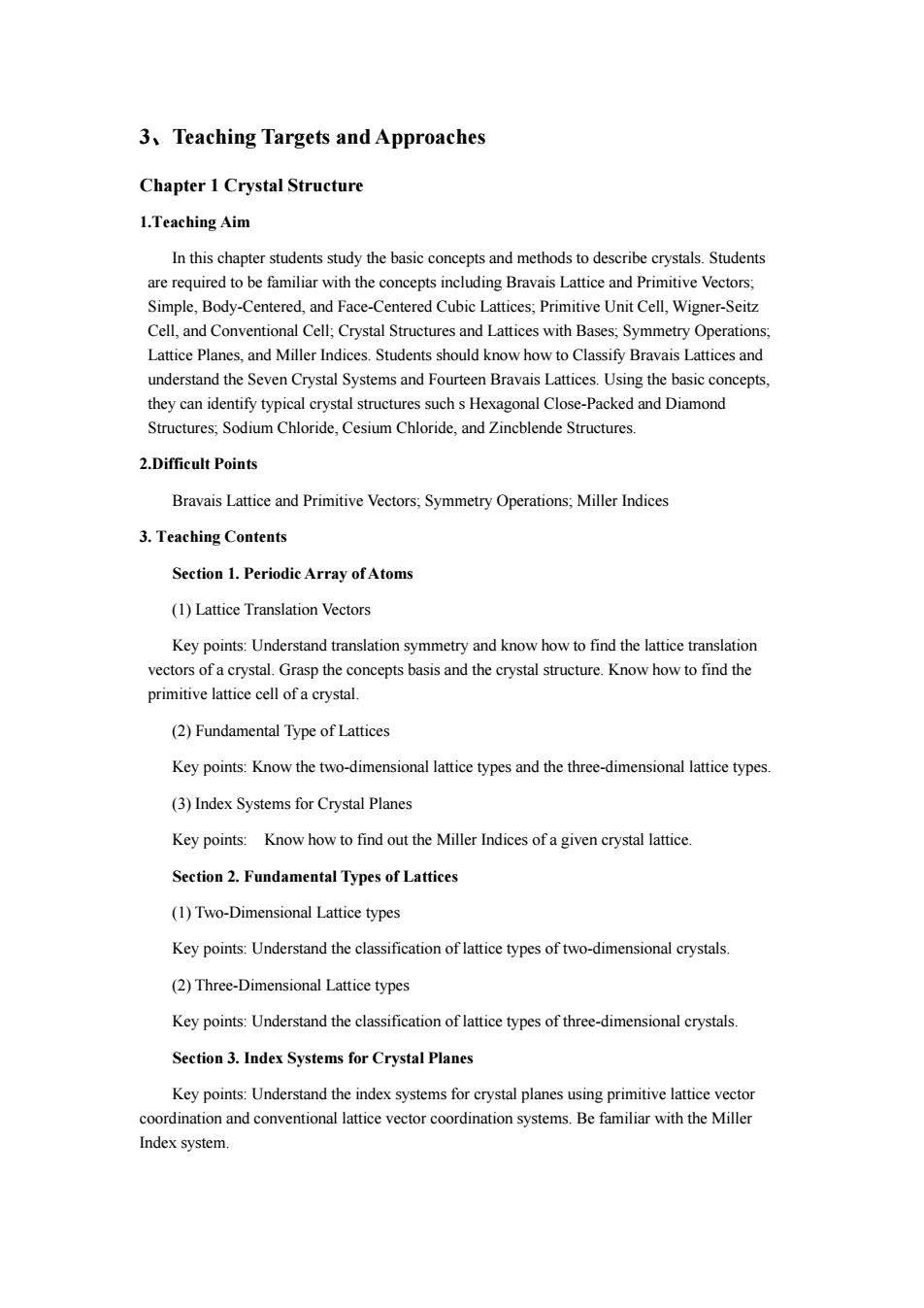正在加载图片...

3,Teaching Targets and Approaches Chapter 1 Crystal Strueture 1.Teaching Aim In this chapter students study the basic concepts and methods to describe crystals.Students familiar ith the Bravais Latticeand Primitive Vector Simple,Body-Centered,and Face-Centered Cubic Lattices,Primitive Unit Cell,Wigner-Seit Cell,and Conventional Cell:Crystal Structures and Lattices with Bases.Symmetry Operations Lattice Planes,and Miller Indices.Students should know how to Classify Bravais Lattices and understand the Seven Crystal Systems and Fourteen Bravais Lattices.Using the basic concepts they Hexonalos-Packed and Diamond Structures Sodium Chloride,Cesium Chloride,and Zineblende Structures 2.Difficult Points Bravais Lattice and Primitive Vectors;Symmetry Operations;Miller Indices 3.Teaching Contents Section 1.Periodic Array of Atoms (1)Lattice Translation Vectors Key points:Understand translation symmetry and know how to find the lattice translation vectors of acrystal Grasp the eoncepts basis and the crystal structure.Know how to find the (2)Fundamental Type of Lattices Key points:Know the two-dimensional lattice types and the three-dimensional lattice types. (3)Index Systems for Crystal Planes Key points:Know how to find out the Miller Indices of a given crystal lattice Section 2.Fundamental Types of Lattices (1)Two-Dimensional Lattice types Key points:Understand the classification of lattice types of two-dimensional crystals (2)Three-Dimensional Lattice types Key points:Understand the classification of lattice types of three-dimensional crystals. Section 3.Index Systems for Crystal Planes Key points:Understand the index systems for erystal planes using primitive lattice vecto coordination and conventional lattice vector coordination systems.Be familiar with the Miller Index system.3、Teaching Targets and Approaches Chapter 1 Crystal Structure 1.Teaching Aim In this chapter students study the basic concepts and methods to describe crystals. Students are required to be familiar with the concepts including Bravais Lattice and Primitive Vectors; Simple, Body-Centered, and Face-Centered Cubic Lattices; Primitive Unit Cell, Wigner-Seitz Cell, and Conventional Cell; Crystal Structures and Lattices with Bases; Symmetry Operations; Lattice Planes, and Miller Indices. Students should know how to Classify Bravais Lattices and understand the Seven Crystal Systems and Fourteen Bravais Lattices. Using the basic concepts, they can identify typical crystal structures such s Hexagonal Close-Packed and Diamond Structures; Sodium Chloride, Cesium Chloride, and Zincblende Structures. 2.Difficult Points Bravais Lattice and Primitive Vectors; Symmetry Operations; Miller Indices 3. Teaching Contents Section 1. Periodic Array of Atoms (1) Lattice Translation Vectors Key points: Understand translation symmetry and know how to find the lattice translation vectors of a crystal. Grasp the concepts basis and the crystal structure. Know how to find the primitive lattice cell of a crystal. (2) Fundamental Type of Lattices Key points: Know the two-dimensional lattice types and the three-dimensional lattice types. (3) Index Systems for Crystal Planes Key points: Know how to find out the Miller Indices of a given crystal lattice. Section 2. Fundamental Types of Lattices (1) Two-Dimensional Lattice types Key points: Understand the classification of lattice types of two-dimensional crystals. (2) Three-Dimensional Lattice types Key points: Understand the classification of lattice types of three-dimensional crystals. Section 3. Index Systems for Crystal Planes Key points: Understand the index systems for crystal planes using primitive lattice vector coordination and conventional lattice vector coordination systems. Be familiar with the Miller Index system